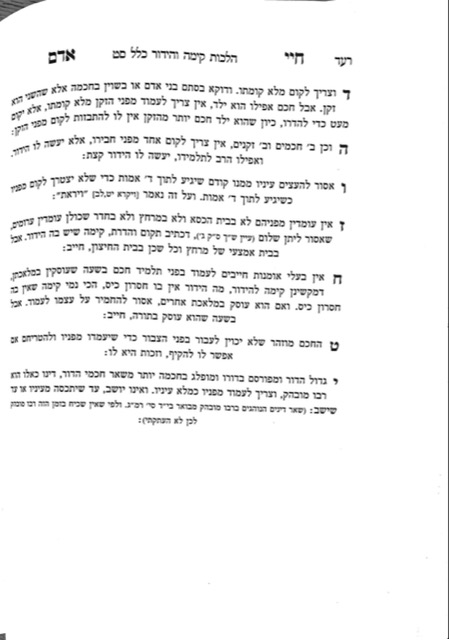We are continuing in the halachos of standing for a talmid chacham. We mentioned in siman 9 that a chacham should not burden the tzibbur and should try to avoid making the tzibbur stand up. The Shach is of the opinion that this halacha applied more at the times of the Gemara, where people sat on the floor and standing up was more of a tircha. Nowadays, where we sit on benches, it is not as much of a tircha so this halacha does not apply. The Birkei Yosef disagrees and holds it still applies equally.
In the sefer ve’ahavta le’reiacha kamocha, the author quotes from the Sefer Hakovetz, which is a sefer printed in the back of the Rambam. He quotes a midrash in Bamidbar Rabbah, that if a rebbe’s intent in making his students stand up is to teach them yiras shamayim, it is appropriate that the rebbe walk in front of them and cause them to need to stand up.
In sefer Pele Yoetz, under the entry kimah, he writes that if a talmid chacham is around people who love mitzvos, it is appropriate for the talmid chacham to walk in front of them, in order to give them the zechus of fulfilling the mitzvah.
Rabbi Reingold heard the following story from Rav Gavriel Ginsberg, who is the Rosh Yeshiva of Ner Yisrael Toronto. He was a talmid of Rav Mottel Katz and Rav Eli Meir Bloch ztl in the 1940’s and 1950’s. He told over that, as American boys, they had no training whatsoever in kavod talmidei chachamim. One time, Rav Eli Meir pushed one of his talmidim to stand up for him. Afterwards, he told them, “do you think I enjoy making you stand up for me? It is very uncomfortable for me to ask you to give me kavod! However, part of my achrayus to you is to teach you chashivus hatorah and keeping mitzvos, one of which includes standing up for a rebbe. Therefore, I have no choice but to go out of my comfort zone to stress to you the importance of standing up, in order for you to learn.”
There is always a concern that people will think that the talmid chacham is requiring people to stand up for his own personal kavod, rather than for kavod hatorah. Even though it is not true, it may be a part of why a talmid chacham should try to avoid making people stand up.
The next question we will discuss is how often one must stand for the rebbe. The Shulchan Aruch writes that one must stand up every time the rebbe passes by. The Rema writes that the chiyuv is to stand only twice per day, once in the morning and once in the evening.
The Rema adds two exceptions. If new people have entered the area, and they have not seen the talmid stand up, they will suspect the talmid of not standing up for his rebbe, so one should stand up again to avoid the maris ayin. In a place such as a yeshiva, where people are coming in all day, it is sufficient to stand up only twice a day, because the newcomers understand that the minhag of the yeshiva is to only stand up twice per day. On the other hand, if there is a situation in which it is common practice for everyone to stand up, such as at the beginning of a shiur, one should stand up with the tzibbur, and refraining from standing up would be interpreted as a bizayon.
Summary
- A talmid chacham should try to avoid making people stand up for him, but if they need to learn kavod hatorah, he should find a balance in which he can teach it to them.
- The Shulchan Aruch holds one should stand for their rebbe every time he passes by. The Rema holds that twice per day is sufficient, unless new people have joined, who did not yet witness this talmid stand up, or if everyone is standing up together, in which case it would be a bizayon for the talmid not to stand up as well.



